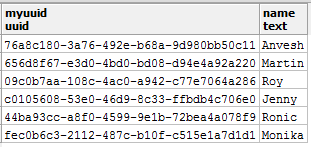
A primary key is a column or a group of columns used to identify a row uniquely in a table. You define primary keys through primary key constraints. PRIMARY KEY constraint. PostgreSQL: Primary Keys.

Here we are considering a single column in a table as. Consider the following table named students. A foreign key is a field or group of fields in a table that uniquely identifies a row in another table. In other words, a foreign key is defined in a table that references to the primary key of the other table. You should always be using a primary key on your table because postgresql internally uses hash table structures to increase the speed of inserts, deletes, updates and selects.
If a primary key column (which is forced unique and non-null) is available, it can be depended on to provide a unique seed for the hash function. It could be a combination of one or more columns and no null values are accepted. Jump to: navigation, search. Any version Written in.

Retrieve primary key columns. In order to “know”, to have a relational database your database need to have a “ primary key ”. Before dig in let’s point some very important aspects of an “ primary key ”: — When define a table and specify a primary key , this table will have only primary key and this is mandatory. The add primary key function lists all of the columns of the table and allows the user to choose one or more columns to add to the primary key for the table. Would there be any problem with listing the index used to enforce the primary key constraint in the Indexes node to let us know of its existence?
It was somewhat confusing to see Indexes(0), and then having to rename an index to rename a primary key constraint. A foreign key constraint, also known as Referential integrity Constraint, specifies that the values of the foreign key correspond to actual values of the primary key in the other table. We see that each row has a UUID id field which is the primary key and was automatically generated for us. These are similar to AUTO_INCREMENT property supported by some other databases.

Query below lists all primary keys constraints (PK) in the database with their columns (one row per column). See also: list of all primary keys (one row per PK). So far we’ve quantified some base line performance on the different primary key types, but only for the most basic test cases. These tests were designed to isolate the effect each type of primary key has, and the are much more pronounced than you’d likely see with a table designed to solve an actual business problem.
The drop primary key function generates the appropriate alter table drop primary key SQL command for dropping the key from the table. When you design your table, you choose to add a primary key constraint for one or more column while create the same. Column attached with primary key constraint should contain UNIQUE and NOT NULL values.
You can have multiple unique constraints. SERIAL data type allows you to automatically generate unique integer numbers ( IDs, identity, auto-increment , sequence) for a column. What is a Primary Key.
In case the primary key contains multiple columns, you must use the table-level constraint. AddressKey As you can see, the mistake is really easy to catch in the second. I would really like to avoid to do the INSERTs all one-by-one, as this will slow down my application extremely, so I hope that anyone solved this issue already! If I have a primary key constraint defined in the database do I also need to create an index on that field for fast lookup? The documentation on the web seems to imply that the contraint is not an index.
I know how to make a primary key within a table, but how do I make an existing index a primary key ? There is second way to create the table with primary key. User directly needs to add the constraint while creating table with primary key. The syntax is bit different for creating table with primary key.
Nessun commento:
Posta un commento
Nota. Solo i membri di questo blog possono postare un commento.